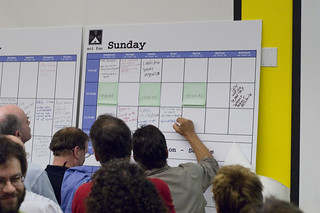They’re trying something new this year at the N.C. Tech for Good Conference. Last year, I helped facilitate the North Carolina nonprofit community’s first experiment with an unconference! It went pretty well, but many NCT4G attendees were not convinced to spend a second day on this strange new format – or maybe they just understandably didn’t want to work on a Saturday.
 This year, I have worked with the conference organizers to develop a hybrid format. I have seen hybrids work well, and I’ve seen them fail badly. I think we have come up with a structure that is truly the best of both worlds. This new approach gives us some reassurance in advance that there will be some great sessions to attend, but also allows the attendees to shape the event into whatever they want and need. Many participants don’t think of themselves as leaders but just as everyone has something to learn, everyone has something to share as well. This event allows all of us to do both.
This year, I have worked with the conference organizers to develop a hybrid format. I have seen hybrids work well, and I’ve seen them fail badly. I think we have come up with a structure that is truly the best of both worlds. This new approach gives us some reassurance in advance that there will be some great sessions to attend, but also allows the attendees to shape the event into whatever they want and need. Many participants don’t think of themselves as leaders but just as everyone has something to learn, everyone has something to share as well. This event allows all of us to do both.
So check out the schedule. Do you see something you’d like to learn? Do have an idea about what is missing? Add it on the wiki. Once we get the conference started, both the pre-selected speakers and the people thinking up emerging proposals will all have the opportunity to “pitch” or explain their session the participants and get added to “the grid.” What happens next is up to us! (For more about this process, see my blog posts from previous unconferences.)
Come on out May 4th – register by Friday the 27th to get the $75 early bird rate – and help us make this the event that you want and need!

 Ruby Sinreich is the Web Maven at
Ruby Sinreich is the Web Maven at 

 This week I have been in geek heaven. Along with the rest of the Duke-based HASTAC staff, I have been testing the
This week I have been in geek heaven. Along with the rest of the Duke-based HASTAC staff, I have been testing the 